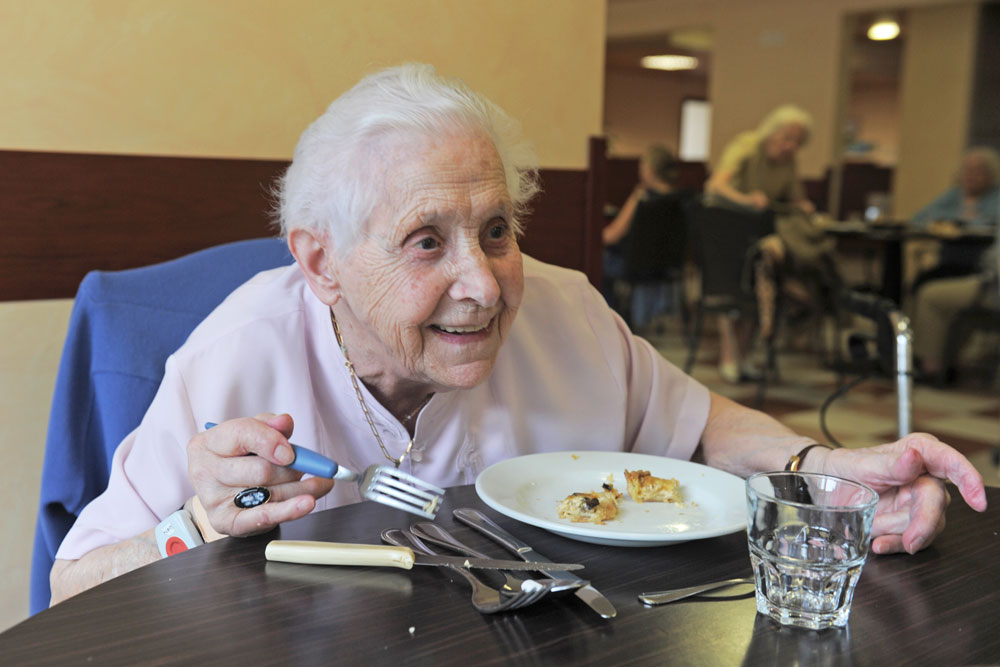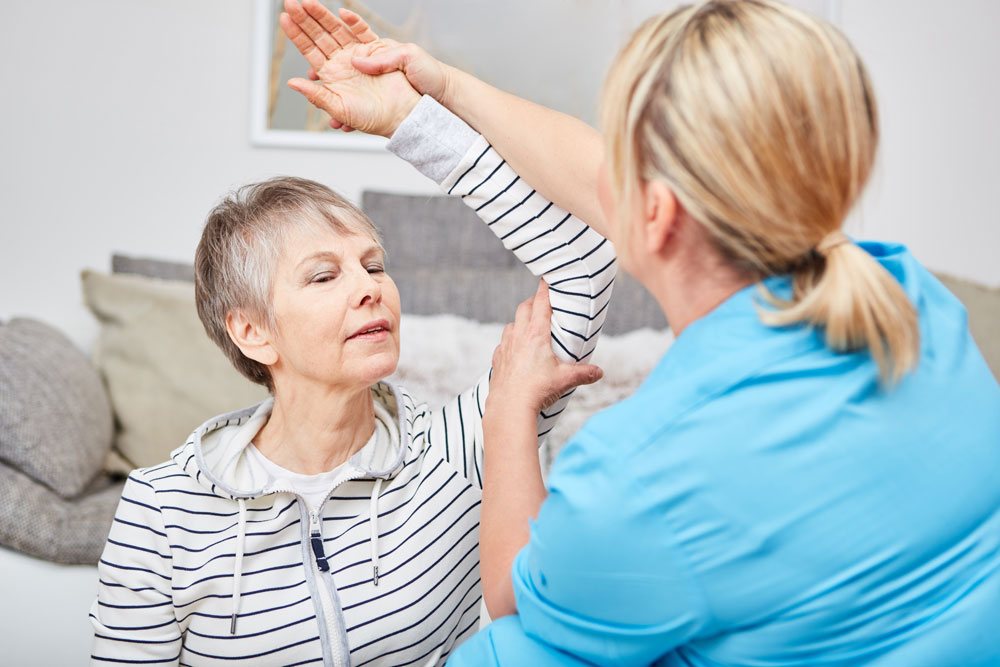Low affective treatment
Communication with our elderly places special demands on those of us who work in care. Facing anger and aggression is part of the work in elderly care. Sadness and frustration can cause irritation, as can difficulties in understanding and being understood. People with dementia or delusions may have difficulty understanding reality and thus feel frustrated by what feels incomprehensible. There is knowledge about how we as fellow human beings and employees in healthcare can act to pour oil on the waves and reduce the risk of violent situations. Low-affective treatment is a tool that means giving messages in short sentences, as those who are upset may have difficulty absorbing more complex messages.
 Foto: Mostphotos
Foto: MostphotosAging in itself means poorer conditions for asserting one's right to self-determination. Nursing staff have a responsibility to be responsive to the resident's wishes. It requires that there is an ongoing discussion about how employees can strengthen the individual's self-determination.
Many elderly people can maintain good contact with relatives by continuing to go and visit or meet in other contexts, which should be encouraged. When the residents feel well and have a meaningful occupation that is planned based on their interests, the staff feel pride and satisfaction while relatives feel secure with the care provided. The elderly stay healthier. A good collaboration between the contact person and relatives builds a foundation for the resident to have the best possible time.
The contact person is therefore something that must be constantly improved, strengthened and developed.
It should be pleasant for relatives to come and visit. The staff's personal treatment colors the atmosphere. Life is not over because you have moved to a nursing home "you have to live until you die". The residents must not sit idle. It often doesn't take much to create activity. It is important to get the employees interested, to make them understand that a lot is about their commitment. It is often time-saving in the long run to take the time to care for the elderly. Care will not be good if those who care do not give of themselves. The burden of care can be reduced through the right interventions.
The role of the contact person is central for the person who moves to a residence, that there is continuity and that the elderly can maintain their contact as much as possible. At the same time, the contact should feel good for the elderly person, and if it does not work, it is better to change the contact person. Continuity increases the resident's ability to maintain their identity and interests. The next of kin must know who the contact person is and be able to reach him. A good relationship between the contact person and the elderly person is the prerequisite for relatives to feel safe and for the resident to receive good supervision and care. The contact person's work must be arranged so that it is possible to create continuity and must, as far as possible, take care of intimate hygiene and other tasks that concern the individual.
The contact person must have an arrival interview with the resident and relatives upon moving into the nursing home and get to know the resident and their life and health history. The contact person must find out how the elderly person wants it, habits and unusual habits. What the resident likes and dislikes and has overall responsibility for ensuring that the elderly can participate in various activities. It can also mean making shorter excursions together with the elderly. It is the contact person's responsibility to ensure that other staff receive information about the new mover. Distribution of responsibility for the resident having hygiene articles, clothes and other things is done in agreement with relatives.
During the last decade, a long series of measures have been taken to strengthen the influence of the individual. We have received a new Patient Act as a result of the patient power investigation. There is talk of person-centred care, the needs of the individual or the elderly at the centre, and other measures to strengthen the resident's right to decide. A knowledgeable and committed contact person is worth its weight in gold to make this happen. Person-centered care means that care focuses more on the resident's resources and experiences and less on illness and difficulties. Person-centredness requires that the resident is actively involved in the planning and execution of the care.
Facing anger
The knowledge of dealing with people who may be angry and threatening has developed over the past decade. With knowledge of low-affective treatment, it is possible to avoid conflicts in the business.
Healthcare professionals occasionally encounter people who are irritated, frustrated, angry or even aggressive. They may use threatening body language, profanity and dominance techniques to emphasize their views or demands. Often these are people who do not feel well themselves and who feel powerless in the face of their life situation. The person who scolds or threatens usually does not experience the problem himself. It is with the rest of us that the problem arises when we feel discomfort or become afraid.
There is an imbalance of power between the person caring for the resident and their relatives. Employees must have the tools and readiness to act in order to act maturely in a conflict. Not infrequently we are co-actors in a process where someone else gets angry. It can be about our body language, what we say or do. Many have learned natural ways of diverting and creating security that calms down the situation. Simple tricks can be backing away a little, lowering your gaze and avoiding eye contact.
Being the "adult in the room" is about the right treatment. We must be professional and the people we meet can often be at an emotional disadvantage for various reasons. Through low-affective treatment, we can prevent or reduce acting out behavior.
Many people probably have experience of situations where a confident person spread calm in a chaotic situation. The art is to adapt the treatment according to the situation that has arisen. In certain situations, touching, eye contact or standing close to someone can be perceived as threatening. Treating someone with respect and calmness and with conscious body language allows that person to "reflect" in the treatment and this often has a calming effect. It is of great importance that we ourselves have the ability to control our own emotions in a situation where the focus is on responding to the person who is in affect and not on the person's behavior.
Planning the day that is known to everyone can create security because events are predictable. When there is information about meals, outside visits and various activities, it has a calming effect. A lot of noise and movement can arouse irritation and anger in vulnerable people. Informing gives the residents the opportunity to choose, and to be able to opt out of presence.
There are methods for dealing with domineering techniques, preventing conflict and dealing with complaints professionally. There are methods to train yourself not to take in too much of what is said. With the right preparedness, it is easier to make wise decisions in pressured situations. It is important to create an alliance with the resident and his relatives so that we can work together to make the care as good as possible for the resident.
If it is a resident or close relative who repeatedly gets angry, there may be reasons to make action plans to support the staff. Guidance can be support for acting correctly but also for processing events that have happened. It is important to break the pattern, otherwise the emotional outbursts can become expected events that are triggered unconsciously by the employees and can lead to change discussions. The resident must move to another unit. Doctors have to insert more drugs and so on. It can end up with the resident being heavily medicated and numb. It can end with fall injuries with fractures that relatives report to the authorities and where the accommodation finally receives serious criticism for its handling of the situation.
A more successful method is to consider how we as employees can change our approach to work with the resident and his relatives. By charting the sequence of events, we can get clues.
In a world where communication is key to almost everything we do, the way we treat each other is critical. A relatively new concept that has begun to gain attention is "low-affective coping." This approach emphasizes empathy, understanding and a softer, less confrontational approach in our relationships and conflict resolution. In this article, we will explore what low-affective behavior is, why it is important, and how it can be used effectively in different contexts.
What is "Low affective treatment"?
Low affective care is a communication and interaction concept that was originally developed to support people with neuropsychiatric functional variations and challenging behaviours. It has since proven to be useful in many different contexts, including education, healthcare, and relationship building.
The main idea behind low-affective behavior is to reduce the emotional tension in a situation. As employees, we strive to reduce negative feelings and increase trust and cooperation. This means avoiding aggression, threats or coercion and instead using empathy and understanding as tools.
Why is low-affective behavior Important?
Improves communication: Low affective behavior creates an environment where people feel more open to express themselves and communicate effectively.
Reduces the risk of threats and violence: Avoiding aggressive or confrontational reactions can prevent situations from escalating to dangerous levels.
Improves relationships: It helps to build stronger and more positive relationships, whether within the family, workplace or community.
Improves self-esteem: Low-affective behavior strengthens the self-esteem of individuals by showing that their opinions and feelings are respected and taken seriously.
How do you use low-affective behavior?
Listen compassionately: Try to understand the other person's perspective and feelings. Listening actively and with empathy creates a strong foundation for low-affective treatment.
Use I messages: Instead of saying "You make me angry," you can say "I feel frustrated when this happens." This reduces recriminations and guilt.
Ask permission: Before offering advice or help, ask if the person is open to it. Respect their boundaries.
Avoid getting defensive: When you feel criticized or attacked, try to avoid getting defensive. Instead, ask questions to understand the other person's concerns or perspective.
Breathe and take breaks: If a conversation becomes intense, take deep breaths and consider suggesting a break to calm emotions.
Look for opportunities for cooperation: Try to find common goals and solutions rather than focusing on conflict.
Low affective behavior is a powerful tool for improving relationships and communication in all contexts. By using it, we can create a more empathetic and harmonious world where we can resolve conflicts and build stronger relationships.
Questions and answers about low affective treatment
What is low-affective behavior and why is it important?
Low-affective treatment is an approach in care and therapy that involves meeting a person with a low emotional tone and neutrality. It is most often used when dealing with challenging behaviors and emotional crises. Low-affective behavior can help reduce conflict and increase cooperation.
What are the advantages of low affective treatment?
The benefits of low-affective coping include reduced escalation of situations, improved communication, increased trust between caregivers and patients, and an increased opportunity to help the person in crisis regain control of their emotions and behaviors.
When should low affective treatment be used?
Low-affective coping is useful in situations where a person is in crisis, upset, or displaying challenging behaviors. It can be used in elderly care, psychiatric care, in the school system and in other situations where emotional reactions and conflicts may arise.
How can I implement low-affective behavior in my work?
To implement low-affective behavior, it is important to understand the basics, such as maintaining a calm and neutral tone, showing empathy and understanding, and avoiding escalating the conflict. Education and practice are essential to mastering this approach.
Are there risks with low affective treatment?
Although low-affective treatment can be effective in many situations, there are risks if it is used incorrectly or if the caregiver is not properly trained. Improper application can lead to a lack of communication or undertreatment of the underlying cause of a person's crisis.
Are there alternatives to low-affective treatment?
Yes, there are different approaches to dealing with challenging behaviors and crises, including high-affective coping, cognitive behavioral therapy, and other forms of support and interventions. The choice of approach depends on the specific situation and the needs of the individual.
Understanding the basic principles of low-affective behavior and how it can be used effectively is valuable for anyone working in the field of health care. It is also important to be aware of when other methods may be more appropriate, and to have a versatile set of tools to meet the different needs of nursing home residents.
Reflection - contact and influence
Care staff:
• Do contact lines work between you as a contact person and those close to you?
• Do you have functioning substitute contact persons when the regular contact person is free for a period?
• Does it happen that you are faced with sad or angry relatives?
• Do you have a colleague who is a role model when it comes to handling conflicts?
Manager, nurse, occupational therapist and physiotherapist:
• How do you support contact persons who find it difficult to manage their role?
• Does the individual have the opportunity to change the contact person if the personal chemistry does not work?
• Are there good routines for threatening and violent situations?
• Do you have access to guidance as support when you need it?
Resident and next of kin:
• Is there a safe employee who has the main responsibility for your loved ones?
• Is there a forum where you as a relative can meet the manager and authorized personnel?
• Have you or your loved one expressed frustration or anger?
Erland Olsson
Head nurse
Sofrosyne
Better care every day

Aktuellt i media
- 2024-04-25 04:00 04 Bemötande
- 2024-04-22 04:00 01 Kvalitet
- 2024-04-18 04:00 10 Aktivitet o funktionsbevarande arbetssätt
-
2024-04-15 04:00
09 Mat och måltid
Food and fall prevention. How the nursing home ensures a safe and nutritious food handling.
info Foto: Mostphotos
Foto: Mostphotos - 2024-04-11 04:00 05 Planering
- 2024-04-08 04:00 10 Aktivitet o funktionsbevarande arbetssätt






